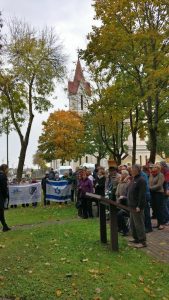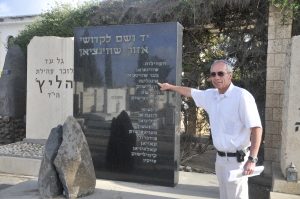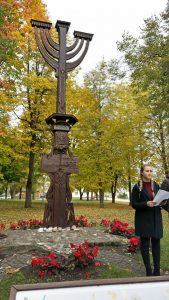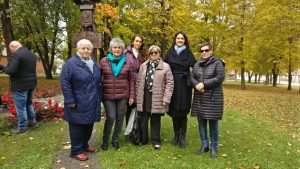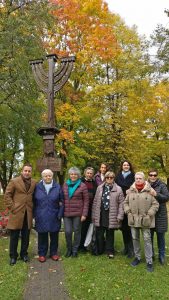Swieciany
In Lithuania Svencionys, In Jewish sources Shwincian.
A town in the district of Vilna, Lithuania, between the 2 world wars I Poland.
Swieciany lies on the highway between Vilna and Moscow, in an area rich in Lakes, rivers and woods, which in the period between the 2 world wars was part of independent Poland. At the time Swieciany was the chief town of a sub-district, which included small towns with Jewish communities of a similar composition, similar community life of religious, cultural and economic services, and the same local branches of the Zionist movements. These small towns were: Nowo Swieciany, Ignalino, Davgielski , Dukszty, Oduciski, Lingmiany, Lyntupy, Mielegiany, Sojaciszki, Podbrodzie, Koltynany, Kiemieliszki, and Cekinie.
Jews were living at Swieciany already in the 9th century. In the 14t century they enjoyed freedom of religion and of trade. Towards the end of the 15th century, following the "Expulsion from Lithuania" (the law expelling the Jews from Lithuania, which was enacted in 1495 under pressure of the church), the Jews found refuge in the estate of Graf Potocki.
In the 16th century the Jews of Swieciany suffered attacks by pilgrims on their way east and by the invading Swedes and Tatars. The population of the town, which included a few hundred Jews, grew only in the middle of the 19th century to reach about 1500 inhabitants.
In 1880 there were already 4480 Jews in the town. Their number decreased to 3172 at the end of the 19th century due to emigration to America, South Africa and Eretz Israel.
The Jewish community of Swieciany had been independent from the beginning of the 19th century. The heads of the community were elected democratically. Their chief task was to control the social, economic and cultural activities of the community, which were financed by local taxes. The Jews comprised at the time about 50% of the town's total population and they were proportionally presented in the town's council. The Polish mayor usually had a Jewish deputy.
The social and charity institutions of the community included, among others, a benevolent fund, an old age home and the care of the sick.
Te cultural activity centered around the educational institute, which had a library, a drama circle, an orchestra and organized lectures. The band of te fire brigade was also composed of members of the community.
Swieciany was known for its rabbis. Rabbi Isaac Jacob Reines one of the great Torah scholars in Lithuania's Jewry, a supporter of general education, te founder of the Mizrachi Movement and an active Zionist, was the Rabbi of the community from 1869 to 1885. Twenty years later, in 1905, he was followed by Rabbi Moshe Avigdor Amiel, who eventually became the Chief Rabbi of Tel-Aviv.
The "Talmud Torah" school of the community was known as one of the best in the Vilna region. The curriculum included secular studies side by side with traditional studies. An elementary Yiddish school was established in 1919, and a group of Jewish Maskilim (enlightened) founded already before WW1 a Jewish gymnasium by the name of "The state gymnasium", which was financed by the community. The Gymnasium, in which the teaching language was Yiddish, was closed down at the end of the 1920's, but the Yiddish elementary school continued to develop and became a state school when the Red Army entered the town in 1939. A Tarbut Hebrew school, with a Zionist orientation, which functioned in the town between the 2 world wars, was closed by order of the Soviet Authorities.
The Jews of Swieciany engaged mostly in trade. Before WW1 Swieciany was a centre for the trade in flux, leather and lamb's wool. The trade in grain, tobacco, cigarettes, soap and spirits was also mostly in Jewish hands. Three printing presses were also owned by Jews.
Two Jewish companies engaged in growing vegetables and medical plants, which they exported to countries in Europe. Among the Jews of Swieciany were also doctors, lawyers and engineers. Poor members of the community were supported by institutions of the community, The Joint, and former Swiecians living abroad.
Local branches of Zionist movements were formed at the town already at the end of the 19th century: Rabbi Reines was active in the Hibbat Zion movement and was in contact with the society for the settlement of Eretz Israel,
In the Mizrachi movement one of the founders was Rabbi Rizovski, who served as the chairman of the community's court and participated in the first Zionist congresses. Oganisations like Zeirei Zion, Hatehiya and Betar were active among the youth of the town in the spheres of culture, education, and work for the Jewish National Fund.
The activity of the Hehalutz and Hehalutz Hazair movements in Swieciany began with the third Alyah to Eretz Israel. Agricultural training centres were set up around the town. The first Halutzim of these centres went to Eretz Israel with the third and fourth waves of Aliyah to the kibbutzim Ein Harod, Yagur, Sedeh Nahum Ramat Hakovesh, Kefar Giladi and Ramat Rahel.
The pro Eretz Israel League in the town included the Zionist and socialist organizations. The general Zionists and Betar drew their membership mostly from the middle class. The artisans and the industrial workers joined the local branch of the Bund. Some Jews were also members of the local Polish Communist party.
In 1939 about 4000 Jews were living in Swienciany.
On September 28, 1939, with the partition of Poland between Nazi Germany and the USSR (following the Molotov-Ribbentrop Pact of August 1938, Swienciany, with the rest of the Vilna region, was annexed to Lithuania. Jewish refugees from the Nazi occupied parts reached Lithuania. They were assisted by the Jewish community of Swienciany and the neighbouring small towns. Most of them continued to move eastward into the USSR and thus survived at the end of the war.
When the war between Germany and the USSR broke out on June 22, 1941, the Red Army retreated and the Lithuanians began a series of robbing and killing Jews. The town was occupied by the Germans and the murder squads of the S.S. also started a systematic slaughter of Jews.
Twenty two Jewish people managed to get hold of weapons and train themselves in the use of arms. At the beginning of March 1943 they joined the partisans in the woods and took part in battles against the Germans and helping Jews from the ghetto of Vilna to escape into the woods.
On July 15, 141, some 100 Jewish men of Swieciany were taken to the woods of Baranov and there shot to death. On Septembe 27, 1941 8000 Jews from the entire region were taken to a deserted military camp in the woods of Polygon and there put to death and buried in a mass grave on the 8th and 9th of October. Among them were 3726 Jews from Swieciany and the vicinity. In the previous evening a few hundred young Jewish men and women succeeded in escaping to the east.
At Swieciany were left only artisans needed by the German army and the Lithuanian administration. The ghetto was surrounded by a barbed-wire fence and guarded by the Lithuanian police. Part of the Jews who managed to avoid the slaughter at Polygon came into the ghetto. At the beginning of 1943 the population of the ghetto reached about 2000 Jews. The ghetto was administrated by a Judenrat of 5 (a council of Jews appointed by the authorities), assisted by a number of Jewish policemen. Because of the shortage of manpower, the Germans for the time being et the Jews of the ghetto to run their own life.
On April 5th, 1943, Jews from the ghetto of Swieciany were put on a train, supposedly for their re-settlement in the ghettos of Kovno and Vilna. But te train stopped at the killing site in the village Ponary, 13 kms south of Vilna. The Jews on the train recognized the malicious scheme and fought the German S soldiers and the Lithuanians policemen with pistols, knives and bare fists. A few score of them managed to escape to Vilna, the others were shot dead on the spot and buried in the ditches of Ponary. 52 of those who succeeded in getting away joined the partisans who fought in the woods of the Vilna region.
Most of the survivors of Swieciany went to Israel after the war where they formed the organization of ex-Swieciany and the neighborhood Jews.
From: Anu Museum
Further reading: Jewish Community of Lithuania
On October 2018 a memorial ceremony was held at the central square in Swieciany. Attended: Chairperson of the Community of Jews from Vilna, Chairperson of Swieciany community in Lithuania and Chairperson of the Association of Jews from Vilna and vicinity in Israel.

